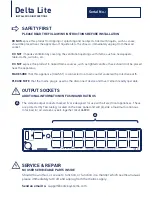
Section 1: Introduction
CP2230 Service Manual
1-7
020-100562-06 Rev. 1 (05-2016)
1.8
Lenses
1.8.1 Primary Lenses
Never apply power to the projector unless the primary lens is installed.
A primary lens inserts into the lens mount and is secured with a simple locking lever. It is important to
remember that a primary lens seals the projector. If the lens is missing when power is supplied to the unit,
unfiltered air will be drawn in through the lens opening and into the front area of the projection head,
potentially depositing dust and dirt on components in the light engine and optics. The attachment of the three-
plate lens mount is offset by jack screws spaced as far apart as possible to provide solid leverage and accurate
adjustment of boresight. Good boresight ensures alignment of the primary lens to the light engine and prism.
Refer to the
CP2230 User Manual (P/N: 020-100430-xx)
for all other primary lens installation details, the
boresight adjustment procedure at the screen, and lens specifications.
1.8.2 Motorized Auxiliary Lens Mount (MALM)
The MALM assembly is an optional hardware component, which when needed can be used to switch from flat
to “scope” formats. This assembly can be secured to the projector base and supports either a 1.25x anamorphic
lens or a 1.26x wide converter lens (WCL). The drive and control electronics package for this motorized
accessory lens mount communicates with and is controlled by the projector over a 9-pin subminiature D cable
that connects to the User I/O panel.
1.8.3 Anamorphic Lens
The optional anamorphic lens (1.25x) can produce 2.39:1 "scope" images when used in combination with the
primary lens. It is secured into a separate lens mount located adjacent to the lens opening and swings into place
in front of the primary lens for scope images. To install the anamorphic lens mount and lens option, refer to the
instructions provided with the anamorphic lens mount kit. The anamorphic lens horizontally spreads the image
back into its wider 2.39:1 scope image and is typically used in side-masking theatres and on larger screens.
When using an anamorphic lens the incoming data must be scaled up to a higher vertical resolution in order to
work correctly.
1.8.4 Wide Converter Lens
In some applications a wide converter lens (WCL) can be used to accommodate changes between flat and
“scope” cinema displays. The wide converter lens “zooms” the image from flat to scope image formats. It
magnifies a scope-formatted 2.39:1 image so it fills the screen without the sue of an anamorphic lens.
Содержание CP2230
Страница 1: ...CP2230 S e r v i c e M a n u a l 020 100562 06...
Страница 2: ......
Страница 3: ...CP2230 S E R V I C E M A N U A L 020 100562 06...
Страница 18: ......
Страница 28: ......
Страница 52: ......
Страница 60: ......
Страница 114: ......
Страница 142: ......
Страница 144: ......
Страница 149: ......
















































